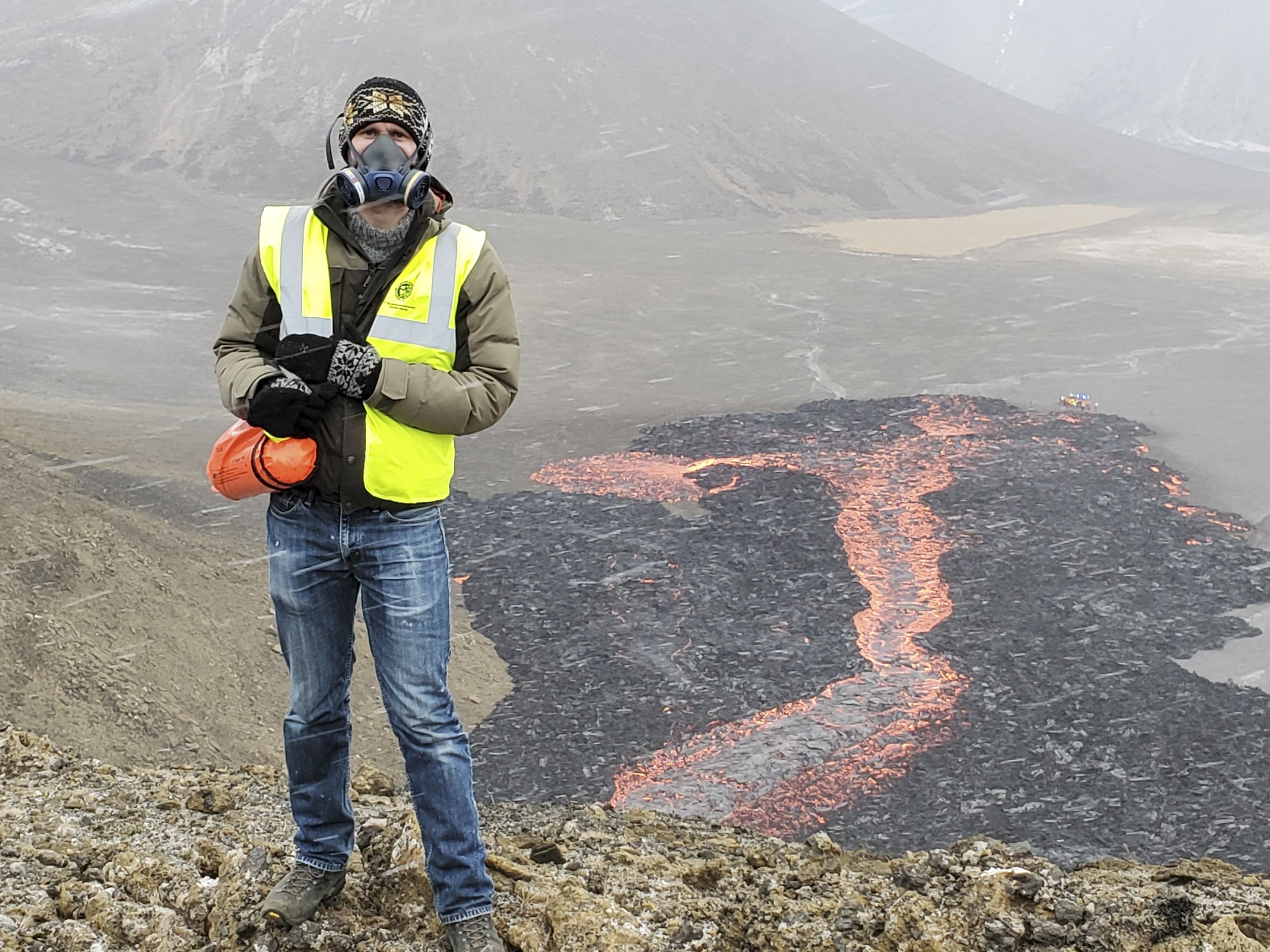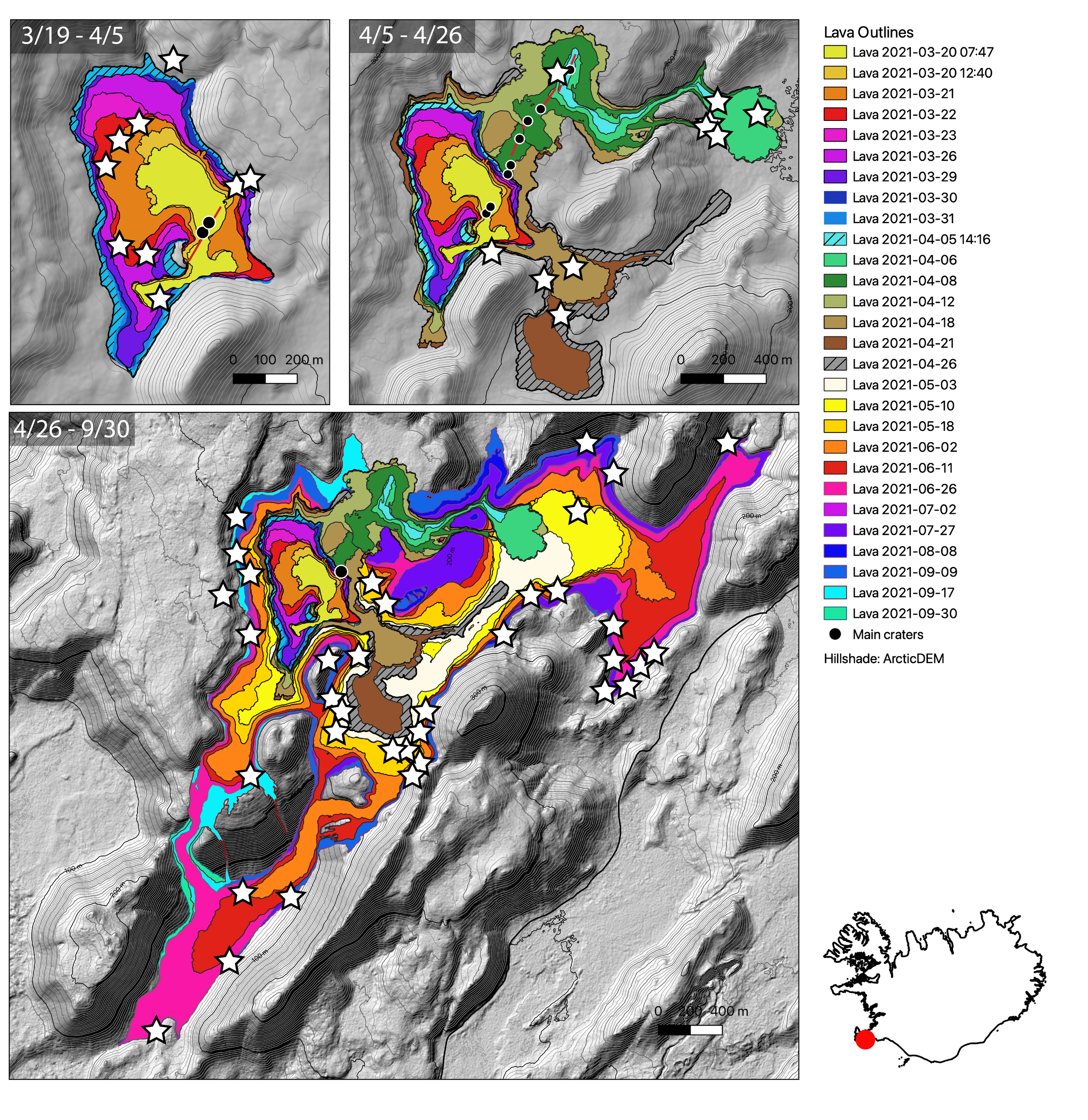Ed Marshall on Iceland’s 2021 Eruption
Ed Marshall is a postdoctoral research fellow at the University of Iceland in mantle geochemistry and igneous petrology. The Fagradalsfjall eruption in the southwest of Iceland provided him with a once-in-a-lifetime opportunity to study lava sources almost directly from the asthenospheric mantle. He describes how he collected lava samples frequently enough to measure the geochemical evolution of the eruption with fine temporal resolution. Preliminary results provide strong evidence for a lava source at the base of the crust where vigorous mixing of a heterogenous mantle is occurring.
Listen to the podcast here or wherever you listen to podcasts.
Scroll down for illustrations that support the podcast.
Note - playing the podcast is not supported on Internet Explorer; please use any other browser, or listen on Spotify, Apple Podcasts, etc.
Podcast Illustrations
All images and video courtesy of Ed Marshall unless otherwise noted.
Sampling the Lava
Ed Marshall wearing protective gear for sampling lava flows. The gear consists of a leather apron, shin guards, sleeves, and gloves. He also wears a specially designed heat-resistant face plate and helmet. He is holding a steel pole with a small scoop welded to the end.
The lava is scooped up and immediately dunked in a bucket of water to convert it into a glass. This inhibits crystallization, preserves any volatiles present in the melt, and ensures that the entire sample is representative of the melt as a whole. If crystals form, the composition of the melt and the crystals would diverge from the original composition of the magma.
Ed Marshall scoops lava from a lava flow. To get the best samples, the cooler, oxidized surface of the flow must be removed to expose the hot pristine interior of the flow. Finding a suitable sample, he quickly pours the sample glob into a bucket filled with water. The water rapidly quenches the surface of the lava glob to glass, but to prevent crystallization in the interior of the lava glob, he hits it with the sampling rod to break it and expose the still-hot interior.
Video of the Eruption
Effusive lava erupting from a small spatter cone fed by two vents on the northern side of the eruption. This type of eruptive activity characterized the early portion of the eruption. In the foreground there is a small lava lake surrounded by a dam of previous lava flows.
This video shows lava advancing rapidly from a newly opened vent.
A small pahoehoe lobe advances on the second day of the eruption. This flow has not travelled far from the vent, and is foamy with gas bubbles. Flows that travel farther from the eruption vent lose their bubbles, becoming denser and less gas-rich.
By mid-May the volcano was erupting rhythmically with large effusion episodes about 15 minutes apart. The reddish hill (left foreground) is all that remains of the first vent. By the end of the eruption, the first vent was completely buried beneath flows from the main vent.
The lithosphere is the rigid upper-most layer of the Earth. It is the lithosphere that is broken up into the large rigid plates whose motions are governed by plate tectonics. In most places, the lithosphere is composed of two compositionally distinct layers - the crust on top, and the lithospheric mantle below. Below the lithosphere lies mantle that is hot enough to flow, i.e., the convecting mantle, the upper-most part of which is the asthenosphere. At rifting plate boundaries and under hot spots, the lithosphere is thought to be thin, and in some cases to comprise only the crustal layer with little or no lithospheric mantle. In the podcast, Ed Marshall suggests that the erupted lava in Iceland comes from a source at the boundary between the asthenosphere and the 15-km-thick crust, there being little or no lithospheric mantle present under the volcano.
Courtesy of the USGS
Evolution of the Eruption
A map of the lava distribution over time. Each color represents the farthest extent of the lava at a given date. The first vent opened in the evening of March 19, 2021. Several new vents opened up on April 5, but by April 27 only a single vent was still active, and remained the only active vent until the end of the eruption. The stars indicate where Ed Marshall sampled the lava.
Map by Gro Pedersen. Data from Landmælingar, Icelandic Institute of Natural History and University of Iceland Institute of Earth Sciences
A time plot of the ratio of the concentration of two trace elements contained within the lava — lanthanum (La) and samarium (Sm). The ratio changes most rapidly at the beginning of the eruption and then stabilizes. These changes are thought to reflect a mixing process in which a batch of melt with high La/Sm mixes with a batch with low La/Sm. The low and high La/Sm melts can be produced from the same mantle by extracting melts from different depths.
A figure depicting mixing within a crust-mantle magma reservoir in which both depleted and enriched melt are introduced to the reservoir and mixed. In another plausible scenario, a "pulse" of enriched melt was injected into the magma reservoir, which then mixed and homogenized during the course of eruption, causing the abundances of trace elements in the lava to stabilize.
Xenoliths and Phenocrysts
Gabbro xenolith included within the lava. Minerals visible within the coarse-grained xenolith include plagioclase (light-colored flecks) and clinopyroxene (dark-colored). These xenoliths are derived from the gabbroic lower crust and the margin of the mantle magma reservoir. The image is about 5 cm across.
Picked olivine crystals from very gas-rich, foamy lavas. The olivines are 'wet' with a thin coating of volcanic glass over their surface. They are derived from deep within the magma system and contain melt inclusions having a wide range of compositions that illustrate the wide range of magma types present at the crust-mantle boundary. Each olivine is about 2mm in size.
Olivine crystal with melt inclusions (circled). Such inclusions preserve pristine samples of the deep melts out of which the olivines formed. The field of view is 5 mm across.










